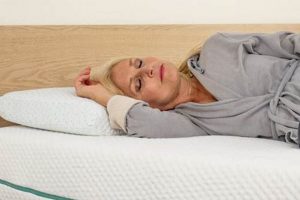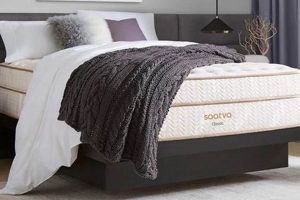The practice of placing a sleep surface directly on the ground is a growing trend, often involving a specific type of pad or cushion designed for this purpose. These items range from simple mats to thicker, more supportive platforms intended to provide comfort and isolation from the floor’s surface. This configuration differs from traditional bed setups that utilize a frame or box spring.
Adopting this sleeping arrangement can offer potential benefits, including improvements in spinal alignment and posture due to the firm surface. Historically, various cultures have embraced ground-level sleeping, citing advantages such as ease of maintenance, space efficiency, and a perceived connection to the earth. The approach may also appeal to individuals seeking minimalist lifestyles or those with limited living spaces.
Considerations before adopting this method include the type of surface used, hygiene practices to prevent mold or dust accumulation, and any pre-existing health conditions that might be aggravated by sleeping on a firmer, lower plane. The subsequent discussion will address these factors in detail, examining suitable surface options, maintenance guidelines, and potential health implications.
Considerations for Ground-Level Sleep Surfaces
Optimizing the experience of placing a sleep surface directly on the floor requires careful attention to several key factors. The following guidance aims to provide practical advice for those considering this alternative sleeping arrangement.
Tip 1: Selection of an Appropriate Surface: Choose a surface specifically designed for floor use. Memory foam, latex, or futon-style pads often provide adequate support and cushioning. Avoid thin blankets or makeshift solutions that may lack sufficient padding and lead to discomfort or injury.
Tip 2: Maintaining Hygiene: Regular cleaning of both the floor and the sleep surface is crucial. Vacuum the floor underneath the sleep surface frequently to remove dust, debris, and potential allergens. Air out the pad regularly to prevent moisture buildup and mold growth.
Tip 3: Ensuring Proper Ventilation: Adequate airflow beneath the sleep surface helps prevent moisture accumulation. Consider using a slatted base or breathable underlayment to elevate the pad slightly and improve ventilation. This is especially important in humid climates.
Tip 4: Implementing Spinal Support: A firm, supportive surface is essential for maintaining proper spinal alignment. Evaluate the density and thickness of the chosen sleep surface to ensure it provides adequate support for the individual’s body weight and sleeping position.
Tip 5: Addressing Potential Health Concerns: Individuals with pre-existing back pain, arthritis, or other musculoskeletal conditions should consult with a healthcare professional before adopting this sleeping arrangement. Modifications to the sleep surface or sleeping position may be necessary to avoid exacerbating these conditions.
Tip 6: Adapting to the Transition: Allow for an adjustment period when transitioning to ground-level sleeping. Begin by using the floor surface for short naps before committing to a full night’s sleep. This allows the body to gradually adapt to the new sleeping arrangement.
Tip 7: Temperature Regulation: The floor can be significantly colder than a raised bed. Ensure adequate insulation and warmth, particularly during colder months. Consider using a thick blanket or heated mattress pad to maintain a comfortable sleeping temperature.
By carefully considering these factors, individuals can maximize the potential benefits and minimize the risks associated with placing a sleep surface directly on the floor. A thoughtful approach ensures a comfortable and supportive sleep environment.
The subsequent sections will delve into the specific materials and products available, providing a more detailed analysis to aid in informed decision-making.
1. Firmness and Support
Firmness and support are foundational considerations when placing a sleep surface directly on the floor. These attributes directly influence spinal alignment, pressure distribution, and overall sleep quality. The selection of an appropriate surface requires a comprehensive understanding of these interacting factors to mitigate potential discomfort or musculoskeletal strain.
- Spinal Alignment and Posture
Insufficient firmness can lead to spinal misalignment, potentially exacerbating existing back pain or creating new discomfort. The absence of adequate support can cause the spine to curve unnaturally, particularly in the lumbar region, leading to muscle strain and compromised posture. A moderately firm surface generally provides the necessary support to maintain a neutral spinal position.
- Pressure Distribution
The level of firmness impacts pressure distribution across the body. A surface that is too soft may concentrate pressure on heavier body parts such as the hips and shoulders, leading to pressure points and restricted blood circulation. Conversely, a surface that is too firm may not provide adequate cushioning, resulting in discomfort and restlessness. Balanced firmness ensures even distribution of weight.
- Material Density and Composition
The density and composition of the sleep surface material directly influence its firmness and support characteristics. High-density memory foam, latex, or futon-style fillings generally offer greater support than less dense materials. The internal structure and layering of these materials also contribute to overall firmness and the ability to conform to the body’s contours.
- Individual Weight and Sleeping Position
Individual body weight and preferred sleeping position are critical determinants of appropriate firmness. Heavier individuals typically require a firmer surface to prevent excessive sinking and maintain spinal alignment. Side sleepers may benefit from a slightly softer surface to accommodate the shoulders and hips, while stomach sleepers generally require a firmer surface to prevent excessive arching of the back. Consideration of these factors is crucial for selecting an optimal sleeping surface.
The interplay between firmness and support dictates the suitability of a sleep surface for floor use. Careful consideration of spinal alignment, pressure distribution, material density, and individual characteristics enables the selection of a surface that promotes comfortable and restorative sleep. Neglecting these factors can lead to discomfort, pain, and potential long-term musculoskeletal issues. The selection process should prioritize surfaces designed for floor placement to ensure both adequate support and hygienic suitability.
2. Material Breathability
Material breathability is a paramount consideration when using a sleep surface directly on the floor. Insufficient airflow can lead to moisture accumulation, fostering an environment conducive to mold growth and compromising sleep hygiene.
- Moisture Regulation and Hygiene
Breathable materials facilitate the evaporation of perspiration, mitigating the build-up of moisture within the sleep surface. This reduces the risk of mold and mildew proliferation, promoting a cleaner and healthier sleep environment. Materials such as open-cell foam, natural latex, and certain synthetic fibers exhibit superior breathability compared to closed-cell alternatives. Proper ventilation is critical, as the floor restricts airflow.
- Temperature Control and Comfort
Breathable materials contribute to effective temperature regulation by allowing air to circulate and dissipate heat. This prevents overheating and promotes a more comfortable sleep experience, particularly in warmer climates or for individuals prone to night sweats. Non-breathable materials can trap heat, leading to discomfort and disrupted sleep patterns. Proper material selection is paramount for thermal comfort.
- Prevention of Allergen Accumulation
Breathable materials are less likely to trap allergens, such as dust mites and pet dander, within the sleep surface. This reduces exposure to allergens and promotes better respiratory health. Materials with inherent antimicrobial properties further enhance allergen control. Regular cleaning and airing of the surface are essential for minimizing allergen accumulation.
- Impact on Material Durability
The breathability of a sleep surface material can influence its longevity. Materials that allow moisture to escape are less susceptible to degradation and compression over time. Reduced moisture accumulation minimizes the risk of structural damage and prolongs the lifespan of the sleep surface. Regular inspection and maintenance are essential for maximizing durability.
The selection of a sleep surface material with adequate breathability is fundamental for maintaining hygiene, ensuring comfort, and prolonging the lifespan of the product when placed directly on the floor. Overlooking this aspect can lead to a range of issues, from compromised sleep quality to potential health hazards. A breathable surface, coupled with appropriate maintenance practices, supports a more sustainable and hygienic sleeping arrangement.
3. Hygiene Maintenance
The placement of a sleep surface directly on the floor necessitates heightened attention to hygiene. The proximity to the ground increases exposure to dust, allergens, and potential moisture accumulation, requiring meticulous and consistent cleaning practices to maintain a healthy sleep environment.
- Regular Vacuuming and Cleaning of the Floor Surface
The floor beneath the sleep surface serves as a reservoir for dust, dirt, and allergens. Regular vacuuming, ideally on a weekly basis, is essential to remove these contaminants. Additionally, periodic cleaning with appropriate floor cleaners helps to eliminate bacteria and mold spores that may proliferate in this environment. Neglecting this aspect can lead to respiratory issues and skin irritations.
- Ventilation and Air Circulation
Inadequate ventilation can trap moisture between the sleep surface and the floor, creating a breeding ground for mold and mildew. Elevating the pad periodically, even slightly, or utilizing a slatted base promotes air circulation and facilitates moisture evaporation. Opening windows to allow fresh air to circulate further enhances ventilation and reduces humidity levels.
- Protective Barriers and Mattress Covers
The use of a waterproof or water-resistant mattress cover provides an additional layer of protection against spills, stains, and moisture penetration. These covers are easily removable and washable, simplifying hygiene maintenance. Additionally, placing a breathable underlayment between the sleep surface and the floor can prevent moisture transfer and minimize wear and tear.
- Routine Inspection and Maintenance
Regularly inspect the sleep surface for signs of mold, mildew, or pest infestations. Address any issues promptly to prevent them from escalating. Airing out the pad in direct sunlight can help to kill bacteria and refresh the material. Proactive inspection and maintenance are crucial for ensuring the long-term hygiene and health of the sleep environment.
Consistent and thorough hygiene maintenance is indispensable when placing a sleep surface directly on the floor. The cumulative effect of neglecting these practices can compromise air quality, promote allergen accumulation, and potentially lead to health issues. Prioritizing cleanliness not only extends the lifespan of the sleep surface but also contributes to a healthier and more comfortable sleep experience.
4. Spinal Alignment
The relationship between spinal alignment and placing a sleep surface directly on the floor is significant, potentially influencing musculoskeletal health. The firmness of a floor-level surface can promote a neutral spinal position, particularly for individuals who typically sleep on overly soft conventional mattresses. Proper spinal alignment during sleep minimizes stress on vertebral discs, reduces muscle strain, and supports optimal nerve function. However, the specific impact varies depending on individual physiology and the surface’s characteristics. For instance, individuals with scoliosis or other spinal deformities may require specialized support that a standard floor-level surface cannot provide, potentially exacerbating their condition. Understanding the cause-and-effect relationship is crucial in evaluating its appropriateness.
The importance of spinal alignment as a component of sleeping on the floor is underscored by its potential to alleviate chronic back pain. A firm surface prevents excessive sinking of the hips and shoulders, maintaining a straighter spinal posture throughout the night. For example, a study published in the Journal of Physical Therapy Science indicated that sleeping on a medium-firm surface can reduce back pain and improve sleep quality compared to sleeping on a soft surface. However, the floor may not be suitable for everyone; elderly individuals or those with limited mobility may find it challenging to get on and off a floor-level sleep surface, potentially leading to falls or other injuries. Therefore, a careful assessment of individual physical capabilities is necessary.
In conclusion, the benefits of improved spinal alignment while placing a sleep surface directly on the floor are contingent on individual health conditions and the selected surface’s properties. While it can offer a cost-effective and space-saving alternative, individuals must consider their specific needs and potential contraindications. The practical significance lies in adopting a mindful approach, consulting with healthcare professionals when necessary, and prioritizing personalized comfort and support to maximize the potential benefits and minimize any associated risks.
5. Thermal Regulation
Thermal regulation is a critical factor influencing the comfort and overall suitability of placing a sleep surface directly on the floor. Proximity to the ground exposes the sleeper to unique temperature dynamics, necessitating careful consideration of materials, insulation, and environmental factors to maintain thermal equilibrium.
- Floor Temperature Conductivity
Floors often exhibit lower temperatures than elevated surfaces due to their direct contact with the ground or foundation. This conductivity can draw heat away from the body, leading to discomfort, particularly during colder seasons. The type of flooring materialconcrete, tile, or woodfurther influences heat transfer rates. Concrete, for instance, has higher thermal conductivity compared to wood, resulting in a colder sleeping surface. Appropriate insulation, such as a thick pad or a thermal barrier, is essential to mitigate this effect.
- Air Circulation and Convection
Air circulation patterns near the floor differ from those at higher elevations. Cooler air tends to settle near the ground, creating a microclimate that can affect thermal comfort. Inadequate ventilation can exacerbate this effect, leading to a feeling of coldness or dampness. Proper air circulation, achieved through open windows or climate control systems, helps to distribute temperature evenly and reduce localized temperature variations. The arrangement of furniture can also influence airflow patterns.
- Material Insulation Properties
The insulating properties of the sleep surface material play a pivotal role in regulating body temperature. Materials such as wool, memory foam, and certain synthetic fibers offer varying degrees of insulation, trapping heat and minimizing heat loss. Thicker pads or multiple layers of bedding provide greater insulation compared to thinner alternatives. Selecting materials with appropriate thermal characteristics is crucial for maintaining a comfortable sleeping temperature, particularly in environments with fluctuating temperatures.
- Seasonal Variations and Climate Control
Seasonal temperature variations necessitate adjustments to thermal regulation strategies. During warmer months, breathable materials and adequate ventilation promote cooling and prevent overheating. In colder months, increased insulation and supplemental heating may be required to maintain a comfortable sleeping temperature. Climate control systems, such as air conditioning and heating, can provide consistent temperature regulation, but their effectiveness depends on proper insulation and airflow management.
The interplay of these factors underscores the importance of a holistic approach to thermal regulation when placing a sleep surface directly on the floor. Failure to address these considerations can compromise sleep quality and potentially impact health. Implementing appropriate insulation, ventilation, and material selection strategies ensures a thermally comfortable and sustainable sleeping arrangement.
6. Space Optimization
The practice of utilizing a sleep surface directly on the floor directly addresses the need for optimized spatial arrangements, particularly in environments where square footage is limited. This approach presents an alternative to conventional bed frames, which inherently occupy a significant volume of living space. The following facets explore the various dimensions of space optimization achieved through this method.
- Multifunctional Room Utilization
The absence of a traditional bed frame allows a room to transition seamlessly between different functions. During the day, the floor space can be readily cleared for activities such as exercise, work, or social gatherings. This adaptability is particularly beneficial in studio apartments or shared living spaces where maximizing utility is paramount. For example, a living room can be transformed into a temporary guest bedroom simply by deploying the sleep surface.
- Reduced Visual Clutter
Low-profile sleep arrangements contribute to a sense of spaciousness by minimizing visual clutter. Traditional bed frames can dominate a room, creating a sense of confinement. Placing the sleep surface directly on the floor reduces the overall height and bulk of the furniture, allowing for a more open and airy aesthetic. This minimalist approach enhances the perceived size of the room, creating a more inviting and comfortable atmosphere.
- Enhanced Storage Potential
While lacking integrated storage solutions inherent in some bed frames, the space beneath a floor-level sleep surface can still be utilized effectively. Low-profile storage containers can be discreetly placed under the pad, providing accessible storage for bedding, clothing, or other items. Alternatively, the absence of a bed frame allows for the placement of other storage units, such as shelving or drawers, against the wall where a conventional bed might otherwise occupy the space.
- Portability and Flexibility
Floor-level sleep surfaces are inherently more portable than traditional bed frames, facilitating easy rearrangement of furniture or relocation within a living space. Lightweight pads or folding mattresses can be quickly moved to accommodate changing needs or to create temporary sleeping arrangements in different rooms. This flexibility is particularly advantageous in rental properties or transient living situations where adaptability is essential.
In summary, utilizing a sleep surface directly on the floor offers a multifaceted approach to space optimization. From enabling multifunctional room utilization to reducing visual clutter and enhancing storage potential, this method provides practical solutions for maximizing the utility and aesthetic appeal of limited living spaces. While not without its considerations, the benefits of space optimization contribute to its appeal, particularly in modern urban environments.
7. Floor Condition
The condition of the floor directly influences the suitability and hygiene of utilizing a sleep surface placed upon it. Factors such as cleanliness, levelness, material composition, and temperature regulation significantly impact the comfort and health implications of this sleeping arrangement.
- Cleanliness and Hygiene
The accumulation of dust, allergens, and debris on the floor surface presents a direct source of contamination for any sleep surface placed upon it. Regular and thorough cleaning is essential to minimize exposure to these potential irritants and pathogens. Hard surfaces, such as tile or wood, can be easily cleaned and sanitized, while carpets may harbor more allergens and require more frequent vacuuming and specialized cleaning methods. Inadequate cleaning can lead to respiratory issues and allergic reactions.
- Levelness and Support
An uneven floor surface can compromise the support and comfort provided by the sleep surface, potentially leading to spinal misalignment and musculoskeletal strain. Unevenness may result from structural irregularities, worn flooring, or underlying imperfections. A level floor ensures uniform support and proper weight distribution across the sleep surface. Adjustments may be necessary to compensate for minor irregularities, such as the use of shims or leveling pads.
- Material Composition and Durability
The type of flooring material influences the durability and lifespan of the sleep surface. Abrasive surfaces, such as concrete or rough tile, can cause premature wear and tear on the underside of the pad. Smoother surfaces, such as finished wood or laminate, are less likely to cause damage. Protective barriers, such as rugs or underlayments, can mitigate abrasion and extend the lifespan of the sleep surface.
- Temperature Regulation and Insulation
The thermal properties of the flooring material impact the temperature of the sleep surface. Floors made of concrete or tile tend to be colder than those made of wood or carpet, potentially leading to discomfort, especially during colder months. Adequate insulation is crucial to minimize heat loss and maintain a comfortable sleeping temperature. The use of rugs, thermal underlayments, or heated mattress pads can enhance insulation and improve thermal comfort.
The facets of floor condition are inextricably linked to the successful implementation of placing a sleep surface directly on the floor. Consistent maintenance and appropriate preparation of the floor are essential for ensuring hygiene, comfort, and the longevity of the sleep surface. Overlooking these aspects can compromise the potential benefits and introduce avoidable health risks.
Frequently Asked Questions
This section addresses common inquiries and misconceptions regarding the practice of placing a sleep surface directly on the floor, providing factual information to aid informed decision-making.
Question 1: Is sleeping on a floor-level surface inherently detrimental to back health?
The impact on back health is contingent on individual physiology and the characteristics of the sleep surface. While a firmer surface may benefit individuals accustomed to overly soft mattresses, those with pre-existing spinal conditions should consult a healthcare professional before adopting this arrangement.
Question 2: How does one mitigate the risk of mold and mildew growth when placing a mattress directly on the floor?
Adequate ventilation is crucial. Regular airing of the sleep surface, coupled with consistent cleaning of the floor beneath, reduces moisture accumulation. Dehumidifiers can also assist in maintaining a dry environment, particularly in humid climates.
Question 3: What types of sleep surfaces are most suitable for floor placement?
Surfaces designed for floor use, such as futon-style mattresses, high-density foam pads, or specialized floor mats, are generally recommended. Thin blankets or makeshift solutions typically lack sufficient support and may compromise spinal alignment.
Question 4: How does floor-level sleeping affect temperature regulation?
Floors tend to be cooler than elevated surfaces. Adequate insulation, such as a thick mattress or thermal underlayment, is essential to minimize heat loss, especially during colder months. Conversely, breathable materials promote airflow and prevent overheating during warmer periods.
Question 5: What are the primary hygiene considerations associated with floor-level sleeping?
Consistent vacuuming of the floor surface is necessary to remove dust, allergens, and debris. Additionally, a protective mattress cover is recommended to prevent stains and moisture penetration. Periodic airing of the sleep surface in direct sunlight helps to kill bacteria and refresh the material.
Question 6: Is floor-level sleeping appropriate for individuals with mobility limitations?
Individuals with mobility limitations, such as the elderly or those with joint pain, may find it challenging to get on and off a floor-level sleep surface. This arrangement may increase the risk of falls or other injuries. Careful consideration of individual physical capabilities is essential.
The preceding questions address core concerns surrounding floor-level sleep surfaces. A thorough understanding of these factors allows for informed decision-making and mitigates potential risks.
The subsequent section will delve into comparative analyses of various sleep surface materials, providing detailed insights into their respective advantages and disadvantages.
Conclusion
The exploration of placing a sleep surface directly on the floor, specifically “sleeping on the floor mattress,” reveals a multifaceted practice with distinct advantages and potential drawbacks. Factors such as spinal alignment, material breathability, hygiene maintenance, and thermal regulation are critical determinants of its suitability. While the arrangement can offer space optimization and potential benefits for back health, careful consideration of individual physical conditions and environmental factors is paramount.
The information presented underscores the need for informed decision-making. The selection of appropriate materials, consistent hygiene practices, and awareness of potential health implications are essential for maximizing benefits and minimizing risks. Further research into the long-term effects of this practice, coupled with personalized assessments, will contribute to a more comprehensive understanding and inform future recommendations.





![Top-Rated Best Sleeping Mattress for Camping: [Year] Guide Organic & Natural Mattress Buyer’s Guide: Non-Toxic Sleep Solutions Top-Rated Best Sleeping Mattress for Camping: [Year] Guide | Organic & Natural Mattress Buyer’s Guide: Non-Toxic Sleep Solutions](https://mattressworldpa.com/wp-content/uploads/2025/07/th-1737-300x200.jpg)

